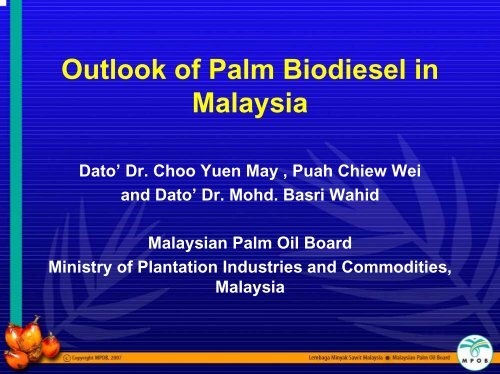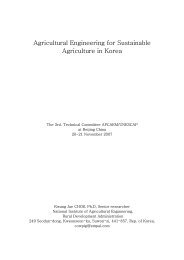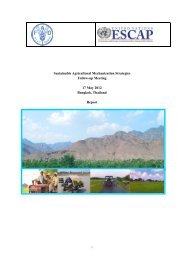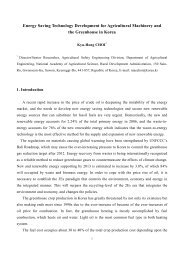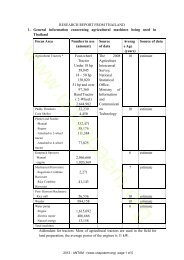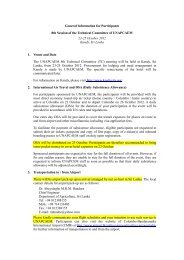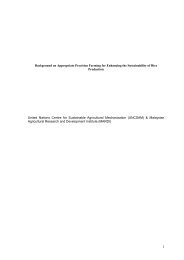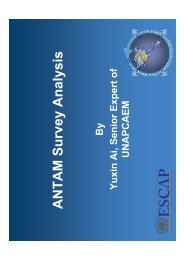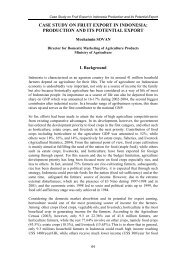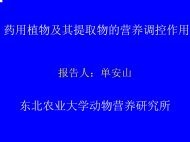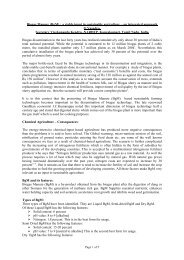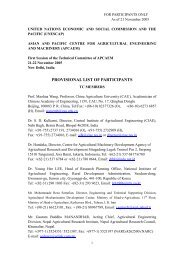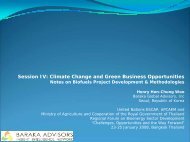Outlook of Palm Biodiesel in Malaysia - CSAM
Outlook of Palm Biodiesel in Malaysia - CSAM
Outlook of Palm Biodiesel in Malaysia - CSAM
Create successful ePaper yourself
Turn your PDF publications into a flip-book with our unique Google optimized e-Paper software.
<strong>Outlook</strong> <strong>of</strong> <strong>Palm</strong> <strong>Biodiesel</strong> <strong>in</strong><br />
<strong>Malaysia</strong><br />
Dato’ Dr. Choo Yuen May , Puah Chiew Wei<br />
and Dato’ Dr. Mohd. Basri Wahid<br />
<strong>Malaysia</strong>n <strong>Palm</strong> Oil Board<br />
M<strong>in</strong>istry <strong>of</strong> Plantation Industries and Commodities,<br />
<strong>Malaysia</strong>
Worldwide <strong>Biodiesel</strong> Development (1)<br />
• Europe – Bi<strong>of</strong>uels Directive (5.75% <strong>of</strong> bi<strong>of</strong>uel <strong>in</strong> 2010<br />
which is 10.2 million T), 4.8 million T production <strong>in</strong><br />
2006.<br />
• US – Program 20 <strong>in</strong> 10 (Achiev<strong>in</strong>g 20% displacement<br />
<strong>of</strong> petroleum with bi<strong>of</strong>uels <strong>in</strong> 10 years (2017), ~1<br />
million T production <strong>in</strong> 2006.<br />
• Ch<strong>in</strong>a – Infancy stage, non-edible feedstock,<br />
estimated 250,000 T production capacity <strong>in</strong> 2007 and<br />
2 million T production <strong>in</strong> 2020.<br />
• Australia – Tallow and UFO feedstock, estimated<br />
80,000 T produced <strong>in</strong> 2006.
Worldwide <strong>Biodiesel</strong> Development (2)<br />
Lead<strong>in</strong>g Asian countries<br />
a) Thailand – Mandate for B2 <strong>in</strong> diesel pool as <strong>of</strong> 2 April 2008.<br />
Beyond 2009, B5 nationwide. Mov<strong>in</strong>g to B10.<br />
b) Philipp<strong>in</strong>es – Coconut feedstock; 11 BD plants with capacity<br />
<strong>of</strong> 300,000 TPA; mandated blend<strong>in</strong>g <strong>of</strong> 1% for all diesel fuel.<br />
c) Indonesia – <strong>Palm</strong> and coconut feedstock; fuel authority<br />
allowed 10% blends <strong>of</strong> biodiesel; production <strong>in</strong> 2006 is<br />
170,000 T; national target: 2.4 million T <strong>in</strong> 2010 and 4.2<br />
million T <strong>in</strong> 2015.<br />
d) South Korea – Any imported feedstocks, 30,000 T produced<br />
<strong>in</strong> 2005, voluntary blend<strong>in</strong>g <strong>of</strong> biodiesel by oil companies –<br />
150,000T from July 2006 – June 2008; B5 for private cars and<br />
B20 for fleet vehicles.
Common Raw Materials for <strong>Biodiesel</strong><br />
Production and Their Oil Yield<br />
Yield<br />
(tonne / ha / yr)<br />
<strong>Palm</strong> Oil (<strong>Malaysia</strong>) 3.93*<br />
Rapeseed (EU) 1.33**<br />
Soyabean (USA) 0.46**<br />
Sunflower (Argent<strong>in</strong>a) 0.66**<br />
Jatropha 1.44***<br />
Coconut (Philipp<strong>in</strong>es) 0.66****<br />
Highest Yield<br />
& Most<br />
Economical<br />
Oil<br />
Source: * MPOB (2006) ** Khoo (2001)<br />
*** Steffan Preusser (2006) **** Oil World (2006)
Feedstock for Production <strong>of</strong> <strong>Biodiesel</strong><br />
Rapeseed oil<br />
Soybean oil<br />
Sunflower oil<br />
<strong>Palm</strong> oil
Availability <strong>of</strong> <strong>Palm</strong> Oil as Feedstock for<br />
<strong>Biodiesel</strong>, <strong>Malaysia</strong> (2007)<br />
• <strong>Malaysia</strong> and Indonesia: World’s largest<br />
producers <strong>of</strong> palm oil<br />
• <strong>Malaysia</strong>: World’s largest exporter <strong>of</strong><br />
palm oil<br />
• Production 15.8 million tonnes<br />
• Exports 13.4 million tonnes<br />
• Export value <strong>of</strong> oil palm products:<br />
RM45 billion
Feedstock Selection<br />
• Availability<br />
– Regional production<br />
– Productivity<br />
• Price<br />
• Characteristics <strong>of</strong> oil<br />
– Stability<br />
– Cold flow properties
Oil <strong>Palm</strong> Plantation
Plantation<br />
<strong>Palm</strong> Tree<br />
Fresh Fruit Bunch
<strong>Palm</strong> Oil Mill
Potential Sources <strong>of</strong> Renewable<br />
Energy from Oil <strong>Palm</strong><br />
Oil <strong>Palm</strong><br />
Fresh Fruit Bunches<br />
Effluents<br />
<strong>Palm</strong> Oil Mill<br />
<strong>Palm</strong> Kernel<br />
Biomass<br />
Empty Fruit<br />
Bunches, Fibre,<br />
Shell, Fronds<br />
Briquette,<br />
Biomass-to-Liquid,<br />
Biomass-to-Gas,<br />
Bioethanol<br />
<strong>Biodiesel</strong><br />
Crude <strong>Palm</strong><br />
Oil<br />
Phytonutrients<br />
<strong>Palm</strong> Kernel<br />
Oil<br />
+<br />
<strong>Palm</strong> Kernel<br />
Cake
Crude <strong>Palm</strong> Kernel Oil<br />
Crude <strong>Palm</strong> Oil<br />
<strong>Palm</strong> Kernel<br />
<strong>Palm</strong> Mesocarp
Empty Fruit Bunches
<strong>Palm</strong> Fibre
<strong>Palm</strong> Shell
<strong>Palm</strong> Kernel Cake
<strong>Palm</strong> Fronds
<strong>Palm</strong> Briquettes<br />
• A clean, uniform and quality fuel<br />
• Improves handl<strong>in</strong>g, physical, chemical and<br />
combustion characteristics<br />
• Save cost <strong>in</strong> biomass disposal and storage,<br />
turn waste <strong>in</strong>to wealth
Conversion to Bioethanol<br />
Ligno-cellulosic biomass<br />
Pretreatment<br />
Cellulose; Hemicellulose; Lign<strong>in</strong><br />
Chemical / Enzymatic Hydrolysis<br />
Lign<strong>in</strong><br />
Sugars<br />
Fermentation<br />
Ethanol Broth<br />
Distillation<br />
Bioethanol
Biogas<br />
• Product from Anaerobic Digestion <strong>of</strong> POME<br />
• Good Energy Resource but Untapped
3,000 tpy <strong>Palm</strong> <strong>Biodiesel</strong> Pilot Plant at MPOB
<strong>Palm</strong> <strong>Biodiesel</strong> (Methyl Esters)<br />
Crude / Distilled <strong>Palm</strong><br />
Oil Methyl Esters<br />
RBD <strong>Palm</strong> Oil<br />
Methyl Esters<br />
RBD <strong>Palm</strong> Ole<strong>in</strong><br />
Methyl Esters
Field Trials us<strong>in</strong>g Mercedes Benz (OM352) Diesel<br />
Eng<strong>in</strong>es Mounted on Passenger Buses<br />
(each bus covered 300,000 km)
MPOB EXPERIENCE: PALM BIODIESEL<br />
(PALM OIL METHYL ESTERS) AS DIESEL<br />
SUBSTITUTE<br />
• No eng<strong>in</strong>es modification is required<br />
• Results <strong>in</strong> terms <strong>of</strong> eng<strong>in</strong>e performance,<br />
fuel consumption, exhaust emission,<br />
repair and ma<strong>in</strong>tenance were promis<strong>in</strong>g<br />
• Cetane number / Diesel Improver ( 62.4 c.f<br />
37.7 for petroleum diesel from Europe)
Recent Trials us<strong>in</strong>g <strong>Palm</strong> <strong>Biodiesel</strong><br />
on Commercial Tra<strong>in</strong>s<br />
• Trials conducted by Prignitzer Eisenbahn (PE)<br />
Arriva <strong>in</strong> Germany, s<strong>in</strong>ce September 2004.
Development <strong>of</strong> MPOB <strong>Palm</strong><br />
<strong>Biodiesel</strong> Technology<br />
(From Research to Commercialization)<br />
• 1 st commercial small scale<br />
plant (3,000 TPA) started<br />
production by August 2002<br />
(Carot<strong>in</strong>o Sdn. Bhd.)<br />
• Scal<strong>in</strong>g up to 60,000 TPA <strong>in</strong><br />
2005.<br />
• Scal<strong>in</strong>g up from 60,000 TPA<br />
to 120,000 TPA <strong>in</strong> 2006<br />
Small scale commercial<br />
Plant, 3,000 TPA (Carot<strong>in</strong>o)
Development <strong>of</strong><br />
W<strong>in</strong>ter Grade <strong>Palm</strong> <strong>Biodiesel</strong> (2001)<br />
• Scal<strong>in</strong>g up to 30,000<br />
TPA <strong>in</strong> 2005<br />
• Commercial<br />
production: 2006<br />
Low Pour Po<strong>in</strong>t <strong>Palm</strong> <strong>Biodiesel</strong><br />
(Pour Po<strong>in</strong>t: 0°C to -20°C)
Seasonal Pour Po<strong>in</strong>t<br />
Requirement <strong>of</strong> <strong>Biodiesel</strong><br />
Summer<br />
Spr<strong>in</strong>g<br />
Autumn<br />
W<strong>in</strong>ter<br />
Season Pour Po<strong>in</strong>t<br />
(°C)<br />
Spr<strong>in</strong>g -10<br />
Summer 0<br />
Autumn -10<br />
W<strong>in</strong>ter -20
Key Fuel Characteristics <strong>of</strong> Normal <strong>Palm</strong> <strong>Biodiesel</strong><br />
and Low Pour Po<strong>in</strong>t <strong>Palm</strong> <strong>Biodiesel</strong><br />
Property<br />
Normal<br />
<strong>Palm</strong> <strong>Biodiesel</strong><br />
Low Pour Po<strong>in</strong>t<br />
<strong>Palm</strong> <strong>Biodiesel</strong><br />
Petroleum<br />
Diesel<br />
Density at 15°C (kg/L)<br />
ASTM D4052<br />
0.875 0.882 0.853<br />
Sulfur Content (% wt)<br />
IP 242<br />
Viscosity @ 40°C (cSt)<br />
ASTM D445<br />
Pour Po<strong>in</strong>t (°C)<br />
ASTM D97<br />
Flash Po<strong>in</strong>t (°C)<br />
ASTM D93<br />
< 0.04 < 0.04<br />
4.5 4.5<br />
+15 -21<br />
174 153<br />
0.10<br />
4.0<br />
+15<br />
98<br />
Cetane Number<br />
ASTM D613<br />
62.4 57 55.2<br />
Gross Heat <strong>of</strong> Combustion<br />
(kJ/kg) ASTM D2332<br />
Conradson Carbon Residue<br />
(% wt) ASTM D198<br />
40,335 39,160<br />
0.02 0.01<br />
45,800<br />
0.14
Fuel Properties <strong>of</strong> <strong>Palm</strong> <strong>Biodiesel</strong> vis-à-vis EN14214 & ASTM D6751<br />
Properties<br />
Unit<br />
EN 14214:2003 ASTM D6751:06<br />
<strong>Palm</strong> <strong>Biodiesel</strong><br />
M<strong>in</strong><br />
Max<br />
M<strong>in</strong><br />
Max<br />
Methanol Content % (m/m) - 0.2 -<br />
-
Fuel Properties <strong>of</strong> <strong>Palm</strong> <strong>Biodiesel</strong> vis-à-vis EN14214 & ASTM D6751<br />
Properties<br />
Unit<br />
EN 14214:2003 ASTM D6751:06<br />
<strong>Palm</strong> <strong>Biodiesel</strong><br />
M<strong>in</strong> Max M<strong>in</strong> Max<br />
Ester Content % mass 96.5 - - - >98.5<br />
Density at 15°C g/cm 3 0.860 0.900 -<br />
- 0.87 – 0.88<br />
Viscosity at 40°C cSt 3.5 5.0 1.9 6.0<br />
4.4<br />
Flash Po<strong>in</strong>t °C 120 - 130 -<br />
> 160<br />
Sulphur Content % mass - 0.001 - 0.0015<br />
6<br />
rat<strong>in</strong>g 1 - -<br />
3<br />
1a<br />
EN14214:2003 European Standard for <strong>Biodiesel</strong><br />
ASTMD6751:06 Standard Specification for <strong>Biodiesel</strong> Fuel (B100) Blend Stock for Distillate Fuels
Fuel Properties <strong>of</strong> <strong>Palm</strong> <strong>Biodiesel</strong> vis-à-vis EN14214 & ASTM D6751<br />
Properties<br />
Unit<br />
EN 14214:2003 ASTM D6751:06<br />
M<strong>in</strong> Max M<strong>in</strong> Max<br />
<strong>Palm</strong> <strong>Biodiesel</strong><br />
Sulphated Ash<br />
Content<br />
Basic Sediment and<br />
Water<br />
% mass - 0.02 - 0.02<br />
Highlights <strong>of</strong> MPOB <strong>Biodiesel</strong><br />
Technology<br />
• Overall yield: 98%<br />
• Products meet<strong>in</strong>g full EN 14214 and ASTM D6751<br />
specifications<br />
• The only plant design optimized for palm oil and<br />
palm oil products as feedstocks<br />
• Simple and proven technology – more than 20 years<br />
<strong>of</strong> experience<br />
• Low pressure & temperature process<br />
• Use cheaper catalyst, NaOH<br />
• Short commission<strong>in</strong>g time<br />
• Technical support from MPOB
MPOB COMMERCIAL PALM BIODIESEL PLANTS<br />
Three (3) demonstration plants were built us<strong>in</strong>g MPOB<br />
Technologies. Each plant consists <strong>of</strong> a 60,000 TPA normal biodiesel<br />
plant and a 30,000 TPA w<strong>in</strong>ter fuel plant.
OTHER PLANTS USING MPOB<br />
TECHNOLOGY<br />
Pulau Indah, Klang, Selangor Darul Ehsan<br />
Capacity : 120,000 tonnes/year<br />
Pasir Gudang, Johor Darul Takzim<br />
Capacity : 120,000 tonnes/year<br />
Surat Tani, Thailand<br />
Capacity: 60,000 tonnes/year<br />
ENERTECH Co. Ltd.<br />
Pyeongtaek, SOUTH KOREA<br />
Capacity: 60,000 tonnes/year<br />
Status : Commissioned
MPOB – CAROTINO PALM BIODIESEL PLANTS<br />
Normal-grade <strong>Palm</strong><br />
<strong>Biodiesel</strong> Plant 60,000 TPA<br />
W<strong>in</strong>ter-grade <strong>Palm</strong> <strong>Biodiesel</strong><br />
Plant 30,000 TPA
Launch<strong>in</strong>g <strong>of</strong> World 1 st Integrated Commercial<br />
Normal and W<strong>in</strong>ter-grade <strong>Biodiesel</strong> Plant at<br />
Carot<strong>in</strong>o Sdn. Bhd. (August 2006)
MPOB – Golden Hope <strong>Biodiesel</strong> Plant, <strong>Malaysia</strong><br />
Normal-grade <strong>Palm</strong><br />
<strong>Biodiesel</strong> Plant<br />
60,000 TPA<br />
W<strong>in</strong>ter-grade <strong>Palm</strong><br />
<strong>Biodiesel</strong> Plant<br />
30,000 TPA
Estimated Cost for the Production<br />
<strong>of</strong> <strong>Palm</strong> <strong>Biodiesel</strong><br />
Oil ~ 70%<br />
Chemicals ~ 10%<br />
Depreciation ~ 7%<br />
Labour ~ 5%<br />
Ma<strong>in</strong>tenance ~ 5%<br />
Utilities ~ 3%<br />
100%
BIODIESEL PRODUCTION - CHALLENGES<br />
• Rise <strong>in</strong> palm oil prices ~ RM1400 <strong>in</strong> 2006 to ~ RM3200<br />
<strong>in</strong> 2007<br />
• Marg<strong>in</strong>s have th<strong>in</strong>ned, <strong>in</strong> fact become negative<br />
(1) Cost <strong>of</strong> RBD palm oil USD1000/tonne<br />
(2) Sell<strong>in</strong>g price <strong>of</strong> biodiesel USD 950/tonne<br />
(3) Cost <strong>of</strong> production USD1120/tonne<br />
<strong>of</strong> palm biodiesel (USD1000 + USD 120)<br />
<strong>Palm</strong> biodiesel is not economically viable<br />
with today’s RBD palm oil price
Environmental Impact <strong>of</strong> <strong>Palm</strong> <strong>Biodiesel</strong><br />
• Environment-friendly – great reduction <strong>in</strong><br />
CO 2<br />
, CO, total unburnt hydrocarbon, SO 2<br />
,<br />
particulates and air toxics<br />
• Biodegradable<br />
• Renewable<br />
• Improved air quality and greenhouse gas<br />
mitigation – reduction <strong>in</strong> health care costs<br />
• In-l<strong>in</strong>e with Clean Development<br />
Mechanism (CDM) <strong>of</strong> 1997 Kyoto Protocol.
Production and Consumption <strong>of</strong> <strong>Palm</strong><br />
<strong>Biodiesel</strong>: A Closed Carbon Cycle<br />
Carbon Dioxide<br />
Emission<br />
<strong>Palm</strong> <strong>Biodiesel</strong><br />
Vehicles Consumption
The Way Forward<br />
(1) Vertical Integration <strong>of</strong> <strong>Palm</strong> <strong>Biodiesel</strong><br />
Production<br />
(2) Production <strong>of</strong> Value-Added Products<br />
from <strong>Palm</strong> <strong>Biodiesel</strong><br />
(3) Production <strong>of</strong> C16/C18 mixed and<br />
C18:1/2 Methyl Esters
(1) Vertical Integration <strong>of</strong> <strong>Palm</strong> <strong>Biodiesel</strong><br />
Production<br />
Plantation Mill Ref<strong>in</strong>ery <strong>Biodiesel</strong><br />
Plant<br />
• More efficient – reduce operation cost<br />
• Excess energy <strong>in</strong> the mill – use for ref<strong>in</strong>ery<br />
and biodiesel production<br />
• For long term susta<strong>in</strong>ability <strong>of</strong> palm biodiesel<br />
production, <strong>in</strong>tegration is a practical<br />
approach.
(2) Production <strong>of</strong> Value-Added Products<br />
from <strong>Palm</strong> <strong>Biodiesel</strong> (Methyl Esters)<br />
PALM PHYTONUTRIENTS
Crude <strong>Palm</strong> Oil ( CPO )<br />
CPO Methyl Esters<br />
(<strong>Palm</strong> Diesel)<br />
Distillation<br />
Distilled Methyl<br />
Esters<br />
(<strong>Palm</strong> Diesel)<br />
(C16/C18 mixed)<br />
Phytonutrients Concentrate<br />
Conta<strong>in</strong><strong>in</strong>g Carotenes, Tocols,<br />
Phospholipids (Lecith<strong>in</strong>),<br />
Sterols, Coenzyme Q and<br />
Squalene<br />
Feedstock for<br />
value-added<br />
oleochemical<br />
products<br />
Carotenes<br />
Tocols<br />
Sterols<br />
Squalene<br />
Coenzyme Q<br />
Phospholipids<br />
(Lecith<strong>in</strong>)
Value-Added Products from<br />
<strong>Palm</strong> Oil Methyl Esters<br />
• For every 1 tonne <strong>of</strong> methyl esters<br />
burnt as fuel, we also burn away:<br />
– 0.6 kg Carotenoids<br />
– 0.8 kg Vitam<strong>in</strong> E<br />
– 0.5 kg Phytosterols<br />
HO<br />
R2<br />
R1<br />
R3<br />
O<br />
– 0.4 kg Squalene<br />
– 0.05 kg Coenzyme Q<br />
– 0.06 kg Phospholipids<br />
H 3<br />
C<br />
C<br />
H 3<br />
O<br />
O<br />
O<br />
O<br />
H<br />
n
For every 1 tonne <strong>of</strong> methyl<br />
esters burnt as fuel, the value <strong>of</strong><br />
phytonutrients burnt away is:<br />
~US 970/tonne<br />
(RM 3,200/tonne)
STRATEGIC THRUSTS<br />
THRUST 1 : USE OF BIOFUEL FOR TRANSPORT<br />
THRUST 2 : USE OF BIOFUEL FOR INDUSTRY<br />
THRUST 3 : DEVELOPMENT OF HOME GROWN<br />
BIOFUEL TECHNOLOGIES<br />
THRUST 4 : PRODUCTION OF BIOFUEL FOR<br />
EXPORT<br />
THRUST 5 : BIOFUEL FOR CLEANER<br />
ENVIRONMENT<br />
• National Bi<strong>of</strong>uel Policy<br />
released 21 March 2006
The National Bi<strong>of</strong>uel Policy<br />
The National Bi<strong>of</strong>uel Policy envisions:<br />
- Use <strong>of</strong> environmental friendly,<br />
susta<strong>in</strong>able and viable sources <strong>of</strong><br />
energy to reduce the dependency<br />
on deplet<strong>in</strong>g fossil fuels<br />
- Enhanced prosperity and well-be<strong>in</strong>g<br />
<strong>of</strong> the stakeholders <strong>in</strong> the agriculture<br />
and commodity based <strong>in</strong>dustries<br />
through stable and remunerative<br />
prices<br />
National Bi<strong>of</strong>uel Policy released 21 March 2006
The National Bi<strong>of</strong>uel Policy<br />
Five (5) Strategic Thrusts<br />
Thrust 1: Bi<strong>of</strong>uel for Transport<br />
Thrust 2: Bi<strong>of</strong>uel for Industry<br />
Thrust 3: Bi<strong>of</strong>uel Technologies<br />
Thrust 4: Bi<strong>of</strong>uel for Export<br />
Thrust 5: Bi<strong>of</strong>uel for Cleaner Environment
The National Bi<strong>of</strong>uel Policy<br />
Five (5) Strategic Thrusts<br />
Thrust 1: Bi<strong>of</strong>uel for Transport<br />
Diesel for land and sea transport will be a<br />
blend <strong>of</strong> 5% processed palm oil and 95%<br />
petroleum diesel. This B5 diesel will be made<br />
available throughout the country. As this<br />
sector is the ma<strong>in</strong> user <strong>of</strong> diesel which is<br />
highly subsidized, it will be given priority <strong>in</strong><br />
this policy.
The National Bi<strong>of</strong>uel Policy<br />
Five (5) Strategic Thrusts<br />
Thrust 2: Bi<strong>of</strong>uel for Industry<br />
B5 diesel will also be supplied to the <strong>in</strong>dustrial<br />
sector <strong>in</strong>clud<strong>in</strong>g for fir<strong>in</strong>g boilers <strong>in</strong><br />
manufactur<strong>in</strong>g, construction mach<strong>in</strong>ery and<br />
generators.
The National Bi<strong>of</strong>uel Policy<br />
Five (5) Strategic Thrusts<br />
Thrust 3: Bi<strong>of</strong>uel Technologies<br />
Research, development and<br />
commercialization <strong>of</strong> bi<strong>of</strong>uel technologies<br />
(<strong>in</strong>clud<strong>in</strong>g technologies for extraction <strong>of</strong> m<strong>in</strong>or<br />
components there<strong>in</strong>) will be effected and<br />
adequately funded by both the government<br />
and private sectors <strong>in</strong>clud<strong>in</strong>g venture<br />
capitalists to enable <strong>in</strong>creased use <strong>of</strong> bi<strong>of</strong>uel.
The National Bi<strong>of</strong>uel Policy<br />
Five (5) Strategic Thrusts<br />
Thrust 4: Bi<strong>of</strong>uel for Export<br />
Worldwide <strong>in</strong>terest reflects the important role <strong>of</strong><br />
bi<strong>of</strong>uels <strong>in</strong> energy for susta<strong>in</strong>able development.<br />
<strong>Malaysia</strong> will have an edge to supply the grow<strong>in</strong>g<br />
global demand for bi<strong>of</strong>uel. The establishment <strong>of</strong><br />
plants for produc<strong>in</strong>g bi<strong>of</strong>uel for export will be<br />
encouraged and facilitated.
The National Bi<strong>of</strong>uel Policy<br />
Five (5) Strategic Thrusts<br />
Thrust 5: Bi<strong>of</strong>uel for Cleaner Environment<br />
The use <strong>of</strong> bi<strong>of</strong>uel will reduce the use <strong>of</strong> fossil<br />
fuels, m<strong>in</strong>imize the emission <strong>of</strong> green house<br />
gases (carbon dioxide), carbon monoxide,<br />
sulphur dioxide and particulates. Increased use<br />
<strong>of</strong> bi<strong>of</strong>uel will enhance the quality <strong>of</strong> the<br />
environment.
LEGAL FRAMEWORK<br />
• <strong>Malaysia</strong>n Bi<strong>of</strong>uel Industry Act 2006<br />
passed by Parliament <strong>in</strong> 2007<br />
• Conta<strong>in</strong>s provision to mandate blend<strong>in</strong>g<br />
<strong>of</strong> bi<strong>of</strong>uel with diesel through<br />
regulations made by M<strong>in</strong>ister<br />
• Draft<strong>in</strong>g <strong>of</strong> regulations under way<br />
• No decision yet on implementation.<br />
Need to consider type <strong>of</strong> bi<strong>of</strong>uel,<br />
percentage, subsidies required etc.
<strong>Malaysia</strong>-Indonesia Jo<strong>in</strong>t Collaboration<br />
• <strong>Malaysia</strong>n – Indonesian pact agrees to use 40% (~6 million<br />
tonnes) <strong>of</strong> current palm oil production (15 million tonnes)<br />
for the production <strong>of</strong> palm biodiesel.<br />
Source: New Straits Times
<strong>Malaysia</strong>n Government Incentives<br />
• Promotion and Investment Act 1986<br />
• Tax <strong>in</strong>centives – Pioneer Status (5 yrs)<br />
(a) Pay tax on 30% <strong>of</strong> its statutory <strong>in</strong>come<br />
(b) Sabah, Sarawak and eastern corridor <strong>of</strong><br />
Pen<strong>in</strong>sular <strong>Malaysia</strong> – 100% tax exemption<br />
on statutory <strong>in</strong>come<br />
• 100% tax exemption on statutory <strong>in</strong>come for<br />
10 years for commercialization <strong>of</strong> R&D<br />
f<strong>in</strong>d<strong>in</strong>gs by Public Sector
<strong>Malaysia</strong>n Bi<strong>of</strong>uels Standards<br />
Bi<strong>of</strong>uel / <strong>Biodiesel</strong> Standards<br />
Vehicle / Eng<strong>in</strong>e<br />
Manufacturer<br />
Authorities<br />
Producers<br />
Suppliers<br />
Users<br />
Environment
<strong>Malaysia</strong>n Bi<strong>of</strong>uels Standard<br />
• Undertaken by SIRIM Berhad, under TC on<br />
Petroleum Fuels.<br />
• Members <strong>of</strong> TC: Oils and Gas Companies, MAA,<br />
MPOB, Government Agencies, MOMG and<br />
biodiesel manufacturers.<br />
• <strong>Malaysia</strong>n Standard on Methyl Esters (similar<br />
to EN 14214); published <strong>in</strong> end <strong>of</strong> 2007.
Representation <strong>of</strong> <strong>Malaysia</strong> <strong>in</strong> Regional<br />
<strong>Biodiesel</strong> Standardization Committees<br />
• Work<strong>in</strong>g Group <strong>of</strong> the Standardization <strong>of</strong><br />
<strong>Biodiesel</strong> Fuel for Vehicles <strong>in</strong> East Asia<br />
• APEC Bi<strong>of</strong>uels Task Force: Guidel<strong>in</strong>es <strong>of</strong><br />
<strong>Biodiesel</strong> Standards <strong>in</strong> APEC<br />
• Jo<strong>in</strong>t Work<strong>in</strong>g Group between ISO/TC 28 and<br />
ISO/TC 34/SC 11: Input/Output Quality <strong>of</strong><br />
Feedstocks and Fatty Acids Esters Used <strong>in</strong><br />
<strong>Biodiesel</strong>
CONCLUSION<br />
• Bi<strong>of</strong>uels contribute to reduction <strong>of</strong><br />
greenhouse gases.<br />
• Solid, liquid and gaseous bi<strong>of</strong>uels can be<br />
produced from various palm sources.<br />
• MPOB palm biodiesel technologies (normal<br />
and w<strong>in</strong>ter grades) have been well proven.<br />
• Both normal and w<strong>in</strong>ter grades palm<br />
biodiesel produced us<strong>in</strong>g MPOB<br />
technologies meet EN14214 and ASTM<br />
D6751 specifications.
CONCLUSION<br />
• MPOB palm biodiesel technology provides<br />
and opportunity to recover value-added palm<br />
phytonutrients.<br />
• <strong>Palm</strong> oil methyl esters (C16 and C18 mixed)<br />
can be used as feedstock for various<br />
oleochemicals applications.<br />
• <strong>Biodiesel</strong> production is economically viable<br />
with <strong>in</strong>tegration <strong>of</strong> phytonutrients production.<br />
• Create more bus<strong>in</strong>ess opportunities.
Acknowledgement<br />
1. M<strong>in</strong>istry <strong>of</strong> Plantation Industries and<br />
Commodities, <strong>Malaysia</strong><br />
2. Former Director-Generals MPOB<br />
- Academician Pr<strong>of</strong>. Emeritus Tan Sri Datuk<br />
Dr. August<strong>in</strong>e Ong S.H.<br />
- Tan Sri Datuk Dr. Yus<strong>of</strong> Basiron<br />
3. MPOB <strong>Palm</strong> <strong>Biodiesel</strong> Technical Team<br />
4. Carot<strong>in</strong>o Sdn. Bhd., Golden Hope <strong>Biodiesel</strong><br />
Sdn. Bhd. and Enertech Co. Ltd.<br />
5. MPOB Technology Licensees, Lipochem Sdn.<br />
Bhd. and Oiltek Sdn Bhd.
Thank You<br />
Please log on to MPOB website for more <strong>in</strong>formation on<br />
biodiesel development (www.mpob.gov.my) or<br />
contact email: choo@mpob.gov.my


